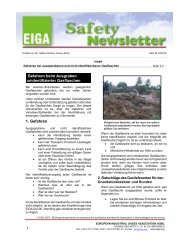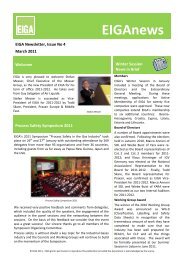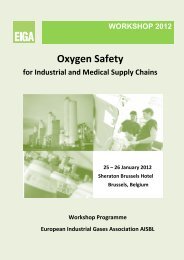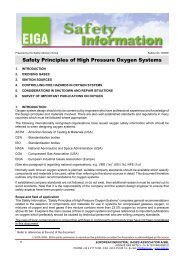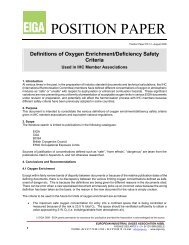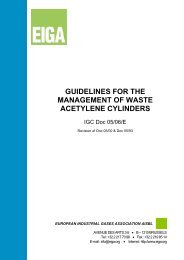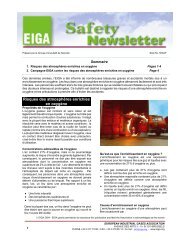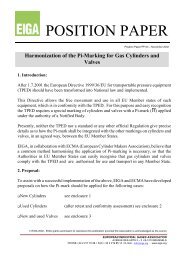CODE OF PRACTICE DRY ICE - eiga
CODE OF PRACTICE DRY ICE - eiga
CODE OF PRACTICE DRY ICE - eiga
You also want an ePaper? Increase the reach of your titles
YUMPU automatically turns print PDFs into web optimized ePapers that Google loves.
IGC DOC 150/08<br />
requirements of a recognised standard such as: EN 352 Hearing Protectors. Safety requirements and<br />
testing. Ear –muffs. (ISO 11904)<br />
The Choice of the hearing protection (e.g. ear defenders, helmet-mounted ear defenders, earplugs<br />
etc) should be determined by taking into consideration both separately and in combination:<br />
• Frequency of use<br />
• Noise level<br />
• Duration of exposure<br />
• Ambient noise level<br />
• Noise frequency<br />
• Additional PPE required for work activity (e.g. gloves, helmet, goggles etc);<br />
Protective clothing<br />
For safety and hygiene reasons the wearing of protective clothing is advisable. Cotton is<br />
recommended.<br />
Note: The following applies specifically to food application. For non-food applications there are no<br />
specific requirements.<br />
General personal hygiene:<br />
In food applications dry ice plant workers will be required to comply with hygiene policy which may<br />
involve the following:<br />
• Working clothes must be clean and laundered on a regular basis.<br />
• Overalls should be food type with no external pockets<br />
• Restrictions on the wearing of jewellery.<br />
• The condition and length of hair and nails.<br />
13 Safety information<br />
All dry ice packaging, plastic, paper or composite bags/wrapping and insulated containers, must be<br />
suitably labelled with all relevant safety information.<br />
“Safety Data Sheet” See appendix IV.<br />
14 Training of personnel<br />
Instruction, training and supervision of all control measures associated with food safety to all 'relevant'<br />
persons (operations, maintenance, external contractors, hauliers, visitors).<br />
Particular attention should be given to:<br />
- the risks and hazards of carbon dioxide and dry ice<br />
- personal hygiene standards<br />
- impact of the job to food safety<br />
- the critical control points of the process.<br />
Training records should be maintained for all personnel.<br />
Special attention should be given to the training needs of new employees.<br />
10



